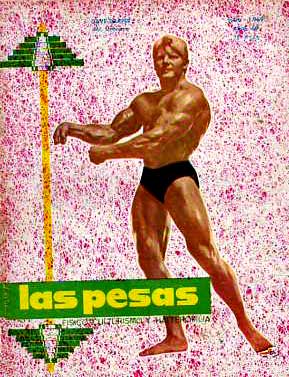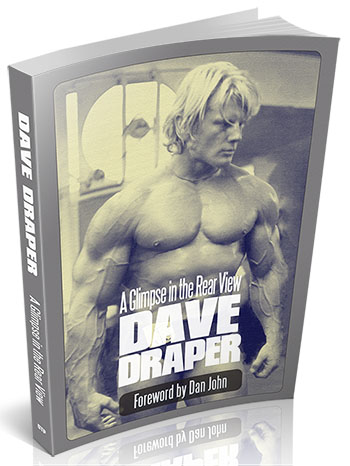Izzo Interview, Part One

Download the full Draper here newsletter
in printable, live-link, pdf format, here.
Only now am I unloosing myself from the holiday chains that bind. I have, as most of us have, applied myself to my training in a diligent, yet less-than-inspiring manner. I did what had to be done, nothing more.
That’s good. Our lifting shouldn’t become a preoccupation, an obsession, an above-all priority. As a part of a healthy and full life with many worthy things to pursue, we want our workouts to accompany and enhance our purposes and projects, our whole life mission.
When the time comes that we need space, we must make space. Be strong and courageous and free.
You’re welcome. I established an excuse-almost-reason for all of us. And now it is time to buckle down. Out with the old and in with the new. Well, not exactly. Unless you’re 15, there’s nothing new about lifting weights. It’s the same old iron and steel, sets and reps, pushes and pulls and ups and down.
It would be discomforting -- frightening -- if it were any other way. Thank heaven for reliability and familiarity and truth.
And so we welcome the first seven days of 2009 with hope and resilience, if not comprehension and good cheer. Last year, the one we most recently endured, was a kicker. Talk about push and pull, up and down.
Enough chatter. I’m settling down to assess myself and put a solid training routine in motion. I plan to persuade Laree to take me to the gym, remove my harness, pat me on the backside and let me graze. Temporarily out of fodder, I offer a recent interview I had with John Izzo, a popular training coach and participant of the IronOnline forum.
IZZO -- DRAPER INTERVIEW
Q) I’m a performance enhancement specialist working with mostly middle-aged golfers and squash players. Another big portion of my clients seek fat loss and just general health improvement.
As we age, that "general health improvement" shifts more towards injury prevention. Do you agree with that statement and if so, when did it hit you that "man, injuries suck"?
A) I gather what you are saying is that sustaining an injury interrupts training progress (general health improvement), a person is more susceptible to injury as he or she ages and greater precautions must be taken to avoid trauma or overload. I agree. However, more than a few competitive athletes insist on training around, through and over an injury despite pain, limitations and increasing damage. Try stopping a raging river.
Ultimately, getting bigger, stronger, faster and more talented shifts beyond injury avoidance to hanging on any way one can. Age grabs hold and the grip tightens. Whether one is a sport competitor or regular working citizen, general health is often sacrificed every day by most everyone: wrong foods, long hours, too much exercise, too little, and then there’s daily living, its stress and dangers.
The course we follow for a long and quality-filled life is circuitous, and guided by instinct and commonsense, actions and reactions... And, if we’re lucky, by the hand of someone like you and your readers. A little knowledge, understanding and care go a long way.
Part two of question A: I think I was 12, the first time I dropped a 25-pound dumbbell on my foot.
The other time was when I fell running full speed down a wooded hillside -- I was a 35-year-old child at the time -- and broke my right collar bone and permanently disconnected my supraspinatus (gone) and biceps insertion of the same side. I taught myself an entirely new training methodology -- don’t ask me to describe it -- based on movement re-invention.
Everyone is different, inside and out. Some would have wisely moved on to jogging and a sedentary career. And you’ll come across those who will insist on pushing it in spite of the writing on the wall.
Q) Dave, I've suffered a pec tear and RTC surgery by the age of 26. Since those injuries it has changed my outlook on training. Was there ever a time or episode that changed the way you train?
A) I expect I answered inquiry that above. My training remained basically the same after a round of healing and readjusting. I trained daily, each bodypart twice a week and limped along, learning and growing. I re-grooved, re-tooled and limited exercise intensity where necessary. Lower body and torso gained added focus. Like I said above, and over and over again, we’re all different, needs, purpose and capacities.
Q) Dave, you've trained with the best. You have been in the best gyms in the country. What things have you seen change in the last 30-40 years in the standard fitness facility?
A) There are about eleven gazillion more gyms today than in 1965 and each with almost that much square footage and machinery, particularly of the aerobic variety. The fancier and more high-tech the gyms are, the less they appeal to me and those of my engagement level and generation. Entertainment is in the air, commerce is the bottom line and mankind’s heart and soul are lacking.
Machines isolate muscles. They remove them from their family and interaction, and the result is a lonely, dysfunctional muscle, lacking strong connections and natural utility. Eventually these less-than-well-rounded muscles complain, causing the whole body to groan.
Certain machines have their worth when injury limits the trainee’s range of motion or stability. I appreciate the Smith Press and plate-loaded dipping machine, for example. As the business has grown, so has the excess -- fitness facilities, equipment manufacturers, silly varieties of muscle-specific equipment and aerobic gadgetry and gear
The iron and the cables rule the gym floor. Barbells and dumbbells, benches and racks and cables of various heights and directions do the healthiest, biggest and best musclebuilding for the tough athlete or the Joe-Jane fitness seeker.
Of course, attention to joint mobility -- hip, pelvis, shoulder, ankle, thoracic spine
and variations of range and muscle recruitment is vitally important, slow to develop, too often forgotten. Here’s where a savvy personal trainer is particularly valuable.
That’s a wrap, bombers, the end of Part One, Part Two next week. Before you know it, next week will be here. Before you know it, next year will be here. Hold onto your barbells, we’re off...
Fly... Godspeed... DD
Click here for Part Two of the Interview.
Soak yourself in a taste of bodybuilding’s Golden Era with Dick Tyler’s on-the-scene record, written in his easy-going, one-of-a-kind style, West Coast Bodybuilding Scene.
Take a trip over to our
New Musclebuilding Q&A Blog
... where Dave allows us a peek into his email outbox.
Did you sign up for Dave's expanded email yet?
It's free, motivating and priceless!
We'll also send you a link to Dave's free
Body Revival Tips and Hints e-report with your confirmation notice.

